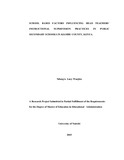| dc.description.abstract | The purpose of the study was to investigate school based factors influencing head
teachers‟ instructional supervision practices in public secondary schools in Thika
East District, Kiambu County, Kenya. The objectives of the study were: to
determine the extent to which school workload, staffing levels, teachers´ attitude
towards supervision and professional experience influences head teachers´
instructional supervision practices. The study was based on social theory of
supervision by John Dawson, (1926). Descriptive survey design was used to carry
out the study. The target population was all 20 public secondary schools in Thika
East District. The sample consisted of 188 respondents and was made up of 20
head teachers, 87 female teachers and 81 male teachers. Census was used to
sample head teachers, purposive sampling was used to sample the schools while
stratified proportionate sampling was used to sample the teachers. The data were
collected using two sets of questionnaires for head teachers and teachers and were
analyzed using descriptive statistics and inferential statistics. ANOVA was used
to analyze research question one while T-tests were used to analyze research
question two, three and four of this study. The findings were summarized and
presented using mean, percentages, frequency distribution tables and graphs. The
study established no statistically significant difference between school workload
and head teachers´ instructional supervision practices the obtained P-value was
0.36 (P>0.05). The study also established no statistical significant difference
between staffing levels and head teachers´ instructional supervision practices. The
obtained P-value was 0.25 (P>0.05). Further, the study established no statistical
significant difference between teachers´ attitude towards supervision and head
teachers´ instructional supervision practices. The obtained P value was 0.53
(P>0.05). Lastly, the study established no statistically significant variations
between head teachers´ professional experience and head teachers´ instructional
supervision practices. The obtained P value was 0.98 (P>0.05). This study
therefore, concludes that: head teachers´ school workload, staffing levels in
schools, teachers´ attitude towards supervision and head teachers´ professional
experience seem not to influence head teachers´ instructional supervision
practices. There could be other factors in play. Based on the sample size the study
recommended that, it may be necessary to carry out a similar study with a larger
sample size to determine the reasons for the inconsistencies in the findings with
previous studies. The study also recommended that head teachers embrace
delegation of tasks to other members of staff. The study also recommended that
teachers be more sensitized through seminars and workshops on the benefits of
instructional supervision in the teaching and learning process. Lastly, the study
recommended that Ministry of Education, Science and Technology to ensure that
training in school management requisite is adhered to before appointment to
headship positions in schools in addition to professional experience and academic
qualifications. | en_US |

